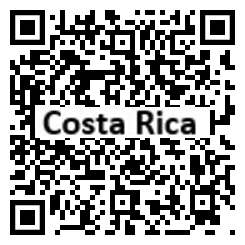Introduction
Background
Costa Rica proclaimed its independence from the United Provinces of central America in 1838. Since the late 19th century, only two brief periods of violence have marred the country’s democratic development. Its standard of living is relatively high and land ownership is widespread.
Geography
Area
total: 51,100 sq km
land: 51,060 sq km
water: 40 sq km
Climate
tropical and subtropical; dry season (December to April); rainy season (May to November); cooler in highlands
Natural resources
hydropower
People and Society
Population
5,256,612 (2023 est.)
Ethnic groups
White or Mestizo 83.6%, Mulatto 6.7%, Indigenous 2.4%, Black or African descent 1.1%, other 1.1%, none 2.9%, unspecified 2.2% (2011 est.)
Languages
Spanish (official), English
Religions
Roman Catholic 47.5%, Evangelical and Pentecostal 19.8%, Jehovah's Witness 1.4%, other Protestant 1.2%, other 3.1%, none 27% (2021 est.)
Population growth rate
0.72% (2023 est.)
Government
Government type
presidential republic
Capital
name: San Jose
Executive branch
chief of state: President Rodrigo CHAVES Robles (since 8 May 2022); First Vice President Stephan BRUNNER Neibig (since 8 May 2022); Second Vice President Mary Denisse MUNIVE Angermuller (since 8 May 2022); note - the president is both chief of state and head of government
head of government: President Rodrigo CHAVES Robles (since 8 May 2022); First Vice President Stephan BRUNNER Neibig (since 8 May 2022); Second Vice President Mary Denisse MUNIVE Angermuller (since 8 May 2022)
Legislative branch
description: unicameral Legislative Assembly or Asamblea Legislativa (57 seats; members directly elected in multi-seat constituencies - corresponding to the country's 7 provinces - by closed party-list proportional representation vote; members serve 4-year terms)
Economy
Economic overview
trade-based upper middle-income economy; green economy leader, having reversed deforestation; investing in blue economy infrastructure; declining poverty until hard impacts of COVID-19; lingering inequality and growing government debts have prompted a liquidity crisis
Real GDP (purchasing power parity)
$109.26 billion (2021 est.)
$101.562 billion (2020 est.)
$105.85 billion (2019 est.)
Real GDP per capita
$21,200 (2021 est.)
$19,800 (2020 est.)
$20,800 (2019 est.)
Agricultural products
sugar cane, pineapples, bananas, milk, oil palm fruit, fruit, oranges, watermelons, cassava, rice
Industries
medical equipment, food processing, textiles and clothing, construction materials, fertilizer, plastic products
Remittances
0.92% of GDP (2021 est.)
0.84% of GDP (2020 est.)
0.86% of GDP (2019 est.)
Exports
$23.761 billion (2021 est.)
$19.996 billion (2020 est.)
$22.738 billion (2019 est.)
Exports - partners
United States 38%, Netherlands 6%, Belgium 5%, Guatemala 5%, Panama 5% (2019)
Exports - commodities
medical instruments, bananas, pineapples, orthopedic appliances, food preparations (2021)
Imports
$22.298 billion (2021 est.)
$17.701 billion (2020 est.)
$20.314 billion (2019 est.)
Imports - partners
United States 41%, China 13%, Mexico 7% (2019)
Imports - commodities
refined petroleum, broadcasting equipment, cars, medical instruments, packaged medicines (2019)
Exchange rates
Costa Rican colones (CRC) per US dollar -
Exchange rates:
620.785 (2021 est.)
584.901 (2020 est.)
587.295 (2019 est.)
576.973 (2018 est.)
567.513 (2017 est.)
Page last updated: Wednesday, December 06, 2023
